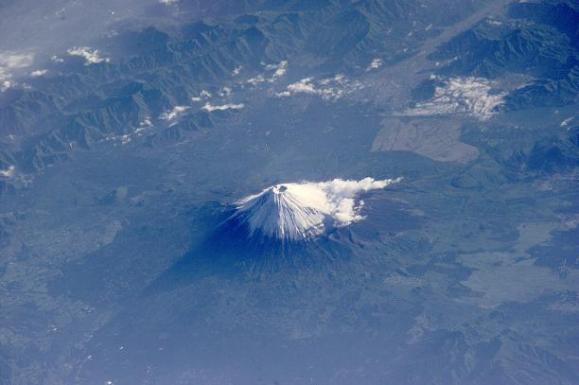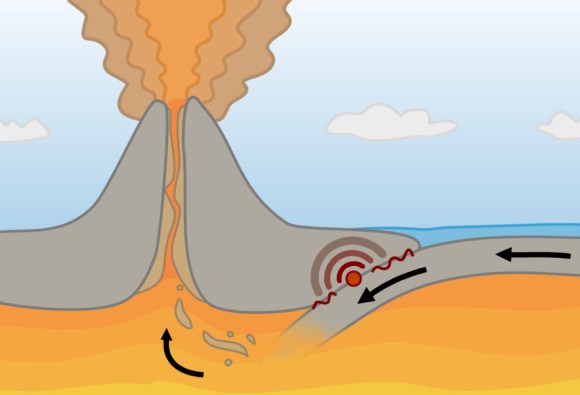 Since the Great Tohoku Earthquake of March 2011, scientists have been anxiously watching the massive volcano known as Mt. Fuji for signs of activity. In September of last year, a report was released stating that Mt. Fuji’s magma chamber pressure had risen to a worrisome 1.6 megapascals, which is estimated to be higher than when it last erupted.
Since the Great Tohoku Earthquake of March 2011, scientists have been anxiously watching the massive volcano known as Mt. Fuji for signs of activity. In September of last year, a report was released stating that Mt. Fuji’s magma chamber pressure had risen to a worrisome 1.6 megapascals, which is estimated to be higher than when it last erupted.
According to retired professor Masaki Kimura of Ryukyu University, this and other recent phenomena indicate an eruption of Mt. Fuji should have taken place in 2011 with a four-year margin of error ending in 2015.
First, a little background on Mt. Fuji. Japan sits on the edge of a “subduction zone” which is where one layer of the Earth’s crust is pushed under another. In the below image, courtesy of Google Maps, you can see the trench along which subduction is occurring around Japan.
This pushing is an ongoing process and results in part of the Earth’s crust being pushed down into the hot magma of the Earth’s mantle. However, because this crust is saturated with water, it mixes differently with the magma in the mantle causing a lighter material to rise back up through the top layer of crust.
This rising magma then becomes a magma chamber. Here, away from the mantle, various gases are released from the magma and accumulate. When pressure becomes stronger than the rock containing it, the rock pops open in a volcanic eruption.
Mt. Fuji was formed in this manner, and the subduction which occurs during large-scale earthquakes is believed to cause an increase in the magma chamber. The previous 1707 eruption of Mt. Fuji is said to have been triggered by a massive earthquake occurring near Osaka a month before.
Prof. Kimura believes that aside from the Tohoku earthquake there has been an overall increase in more “normal” seismic activity around the mountain – particularly on its northeast side.
“Magma is rising from beneath Mt. Fuji. Cracks in the crust have been growing. Some things hanging above have been falling. No one is pointing it out, but I think there is a possibility.”
By “things hanging”, Prof. Kimura is possibly alluding to the partial collapse of the Sasago expressway tunnel in December last year, which killed nine. Authorities are still investigating the cause of the collapse and no earthquake was detected at the time, but deformation of the tunnel is speculated as being the cause.
Prof. Kimura also mentions the rise of the water level at Lake Sai which is located to the northeast of Mt. Fuji. At the time of the Tohoku earthquake, the lake’s water-level rose by one meter. Kimura believes that this was caused by the permafrost near Fuji’s summit melted by rising magma.
Prof. Kimura also claims that there have been a large number of phreatic eruptions – explosions of steam caused by heating of ground water from rising magma – around the mountain. No lava is released during these explosions, only water and rock.
However, some say that phreatic eruptions are precursors to major volcanic eruptions. Prior to the 1980 eruption of Mt. Saint Helens in the US, there were numerous reports of phreatic eruptions. This is a theory which Prof. Kimura seems to agree with.
“It looks like the danger of eruption is in the northeast corner of Mt. Fuji, but there is also a possibility of an eruption from the summit crater at the same time. Volcanic earthquakes are increasing, and their epicenters are becoming increasingly shallow.”
It should be noted that Prof. Kimura is co-author of Fujisan No Funka Wa Hajimatteiru! (The Eruption of Mt. Fuji Has Begun!), a book released in June last year, as well as author of 2011’s Fujisan Dai Funka! Bukimina Itsutsu No Choko (Mt. Fuji’s Big Eruption! Five Eerie Signs).
Also, despite the evidence at hand it is still difficult to predict disasters like earthquakes and volcanic eruptions with absolute accuracy.
However, in the event of a Mt. Fuji eruption, many speculate the cost to human life would be low due to the slow moving lava that would likely occur. On the other hand, the cost of damage to public and private property would undoubtedly be immense.
So if you’re planning purchasing any property in the vicinity of Mt. Fuji, you might want to sit on it for a while.
Source: livedoor News via Hachima Kiko (Japanese)
Amazon: Fujisan No Funka Wa Hajimatte Iru!
Top Image: Wikipedia
Volcano Diagram: Wikipedia
Mt Fuji


 Major eruption could cause Mt. Fuji’s new life as Cultural Heritage Site to be short lived
Major eruption could cause Mt. Fuji’s new life as Cultural Heritage Site to be short lived Is Mt. Fuji About to Blow Its Top?
Is Mt. Fuji About to Blow Its Top? Mt Fuji looks unusual, sparks fears of possible eruption
Mt Fuji looks unusual, sparks fears of possible eruption Pizza Hut Japan’s hot lucky bags are perfect for a New Year’s pizza party
Pizza Hut Japan’s hot lucky bags are perfect for a New Year’s pizza party Harajuku’s new permanent Tamagotchi shop is filled with cuteness and a surprising lack of poop
Harajuku’s new permanent Tamagotchi shop is filled with cuteness and a surprising lack of poop 7 great places to see Mt. Fuji from without having to climb it
7 great places to see Mt. Fuji from without having to climb it Kawaii Monster Land getting set to become Harajuku’s newest whimsical underground wonderland
Kawaii Monster Land getting set to become Harajuku’s newest whimsical underground wonderland What part of Japan has the best food, and what should you eat there?
What part of Japan has the best food, and what should you eat there? Are 100-yen shop Daiso’s gel nail polish strips a good dupe for salon quality nails? Let’s find out
Are 100-yen shop Daiso’s gel nail polish strips a good dupe for salon quality nails? Let’s find out Let’s go open a Lego Japan lucky bag…o
Let’s go open a Lego Japan lucky bag…o Birth Japan’s 2023 Lucky Bag will bring out your inner Japanese gangster【Photos】
Birth Japan’s 2023 Lucky Bag will bring out your inner Japanese gangster【Photos】 A Japanese tea house for inside your house? Tokyo company wants to offer micro chashitsu overseas
A Japanese tea house for inside your house? Tokyo company wants to offer micro chashitsu overseas Burger King Japan’s Ugly Burgers go head-to-head in a battle for flavour
Burger King Japan’s Ugly Burgers go head-to-head in a battle for flavour Starbucks Japan ready to get Year of the Horse started with adorable drinkware and plushies【Pics】
Starbucks Japan ready to get Year of the Horse started with adorable drinkware and plushies【Pics】 7-Eleven Japan’s ramen-cooking robot whipped us up a bowl of noodles【Taste test】
7-Eleven Japan’s ramen-cooking robot whipped us up a bowl of noodles【Taste test】 Cyberpunk anime meets traditional culture in Ghost in the Shell gold leaf Japanese changing screens
Cyberpunk anime meets traditional culture in Ghost in the Shell gold leaf Japanese changing screens Hello Kitty Choco Egg figures are an adorable trip through three periods of Japanese pop culture【Pics】
Hello Kitty Choco Egg figures are an adorable trip through three periods of Japanese pop culture【Pics】 Japan’s otoshidama tradition of giving kids money at New Year’s gets a social welfare upgrade
Japan’s otoshidama tradition of giving kids money at New Year’s gets a social welfare upgrade We found possibly the quietest Japanese-style hotel in Tokyo’s bustling Shinjuku district
We found possibly the quietest Japanese-style hotel in Tokyo’s bustling Shinjuku district Lacquerware supplier to emperor of Japan and Pokémon team up for new tableware
Lacquerware supplier to emperor of Japan and Pokémon team up for new tableware Sumo Sanrio! Hello Kitty and pals team up with Japan Sumo Association for new merch【Pics】
Sumo Sanrio! Hello Kitty and pals team up with Japan Sumo Association for new merch【Pics】 Can a dirty butthole make you filthy rich in Japan? We’re starting a New Year’s lottery experiment
Can a dirty butthole make you filthy rich in Japan? We’re starting a New Year’s lottery experiment 7-Eleven Japan starts new temporary luggage storage service in over 300 branches
7-Eleven Japan starts new temporary luggage storage service in over 300 branches Disillusionment at Tsukiji’s tourist-target prices led us to a great ramen restaurant in Tokyo
Disillusionment at Tsukiji’s tourist-target prices led us to a great ramen restaurant in Tokyo Starbucks teams up with 166-year-old Kyoto doll maker for Year of the Horse decorations【Photos】
Starbucks teams up with 166-year-old Kyoto doll maker for Year of the Horse decorations【Photos】 Tokyo considering law requiring more trash cans following litter increase in heavily touristed area
Tokyo considering law requiring more trash cans following litter increase in heavily touristed area Tokyo’s Tsukiji sushi neighborhood asks tour groups to stay away for the rest of the month
Tokyo’s Tsukiji sushi neighborhood asks tour groups to stay away for the rest of the month Nintendo’s Kirby now delivering orders at Kura Sushi restaurants, but not in Japan
Nintendo’s Kirby now delivering orders at Kura Sushi restaurants, but not in Japan Tokyo event lets you travel back in time, for free, to celebrate 100 years since Showa era start
Tokyo event lets you travel back in time, for free, to celebrate 100 years since Showa era start Sanrio theme park in Japan announces plans to expand into a Sanrio resort
Sanrio theme park in Japan announces plans to expand into a Sanrio resort Japan may add Japanese language proficiency, lifestyle classes to permanent foreign resident requirements
Japan may add Japanese language proficiency, lifestyle classes to permanent foreign resident requirements Survey asks foreign tourists what bothered them in Japan, more than half gave same answer
Survey asks foreign tourists what bothered them in Japan, more than half gave same answer Japan’s human washing machines will go on sale to general public, demos to be held in Tokyo
Japan’s human washing machines will go on sale to general public, demos to be held in Tokyo Japan’s deadliest food claims more victims, but why do people keep eating it for New Year’s?
Japan’s deadliest food claims more victims, but why do people keep eating it for New Year’s? We deeply regret going into this tunnel on our walk in the mountains of Japan
We deeply regret going into this tunnel on our walk in the mountains of Japan Studio Ghibli releases Kodama forest spirits from Princess Mononoke to light up your home
Studio Ghibli releases Kodama forest spirits from Princess Mononoke to light up your home Major Japanese hotel chain says reservations via overseas booking sites may not be valid
Major Japanese hotel chain says reservations via overseas booking sites may not be valid Put sesame oil in your coffee? Japanese maker says it’s the best way to start your day【Taste test】
Put sesame oil in your coffee? Japanese maker says it’s the best way to start your day【Taste test】 No more using real katana for tourism activities, Japan’s National Police Agency says
No more using real katana for tourism activities, Japan’s National Police Agency says Starbucks Japan reveals new sakura drinkware collection, inspired by evening cherry blossoms
Starbucks Japan reveals new sakura drinkware collection, inspired by evening cherry blossoms Updated cherry blossom forecast shows extra-long sakura season for Japan this year
Updated cherry blossom forecast shows extra-long sakura season for Japan this year
Leave a Reply